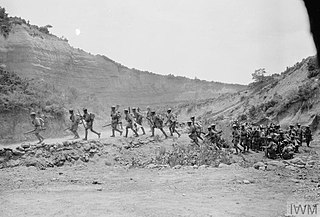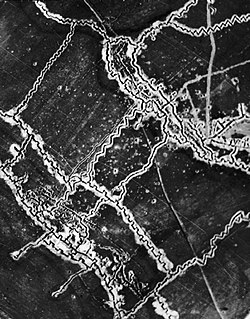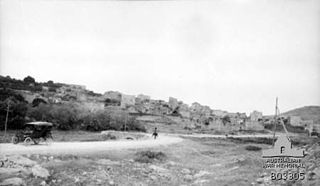
The First Battle of Krithia was the first Allied attempt to advance in the Battle of Gallipoli during the First World War. Starting on 28 April, three days after the Landing at Cape Helles, the defensive power of the Ottoman forces quickly overwhelmed the attack, which suffered from poor leadership and planning, lack of communications and exhaustion and demoralisation of the troops.

The Third Battle of Krithia, fought on the Gallipoli peninsula during World War I, was the last in a series of Allied attacks against the Ottoman defences aimed at achieving the original objectives of 25 April 1915. The previous failures in the first and second battles resulted in a less ambitious plan being developed for the attack, but the outcome was another costly failure for the Allies. The allied aim was, as always to facilitate the capture of Alçı Tepe which commanded most of the peninsula.

The Battle of Gully Ravine (Zığındere) was a World War I battle fought at Cape Helles on the Gallipoli peninsula. By June 1915 all thoughts the Allies had of a swift decisive victory over the Ottoman Empire had vanished. The preceding Third Battle of Krithia and the attack at Gully Ravine had limited objectives and had much in common with the trench warfare prevailing on the Western Front. Unlike previous Allied attacks at Helles, the Gully Ravine action was largely successful at achieving its objectives though at a typically high cost in casualties.

The first day on the Somme, 1 July 1916, was the beginning of the Battle of Albert (1–13 July), the name given by the British to the first two weeks of the 141 days of the Battle of the Somme in the First World War. Nine corps of the French Sixth Army and the British Fourth and Third armies attacked the German 2nd Army from Foucaucourt to the south of the Somme, northwards across the Somme and the Ancre to Serre and at Gommecourt, 2 mi (3 km) beyond, in the Third Army area. The objective of the attack was to capture the German first and second defensive positions from Serre south to the Albert–Bapaume road and the first position from the road south to Foucaucourt.

The Battle of the Ancre Heights, is the name given to the continuation of British attacks after the Battle of Thiepval Ridge from 26 to 28 September during the Battle of the Somme. The battle was conducted by the Reserve Army from Courcelette near the Albert–Bapaume road, west to Thiepval on Bazentin Ridge. British possession of the heights would deprive the German 1st Army of observation towards Albert to the south-west and give the British observation north over the Ancre valley to the German positions around Beaumont-Hamel, Serre and Beaucourt. The Reserve Army conducted large attacks on 1, 8, 21, 25 October and from 10 to 11 November.

The Battle of Ctesiphon was fought in November 1915 by the British Empire, against the Ottoman Empire, within the Mesopotamian Campaign of World War I.

The Mesopotamian campaign was a campaign in the Middle Eastern theatre of World War I fought between the Allies represented by the British Empire, troops from Britain, Australia and the vast majority from British India, against the Central Powers, mostly from the Ottoman Empire.

The Fall of Baghdad occurred during the Mesopotamia Campaign, fought between the forces of the British Empire and the Ottoman Empire in the First World War.

The Raid on the Suez Canal, also known as Actions on the Suez Canal, took place between 26 January and 4 February 1915 when a German-led Ottoman Army force advanced from Southern Palestine to attack the British Empire-protected Suez Canal, marking the beginning of the Sinai and Palestine Campaign (1915–1918) of World War I (1914–1918).

The Capture of Schwaben Redoubt was a tactical incident in the Battle of the Somme, 1916 during the First World War. The redoubt was a German strong point 500–600 yd (460–550 m) long and 200 yd (180 m) wide, built in stages since 1915, near the village of Thiepval and overlooking the River Ancre. It formed part of the German defensive system in the Somme sector of the Western Front during the First World War and consisting of a mass of machine-gun emplacements, trenches and dug-outs. The redoubt was defended by the 26th Reserve Division, from Swabia in south-west Germany, which had arrived in the area during the First Battle of Albert in 1914. Troops of the 36th (Ulster) Division captured the redoubt on 1 July 1916, until forced out by German artillery-fire and counter-attacks after dark.

The Battle of Dujaila was fought on 8 March 1916, between British and Ottoman forces during the First World War. The Ottoman forces, led by Colmar Freiherr von der Goltz were besieging Kut, when the Anglo-Indian relief force, led by Lieutenant-General Fenton Aylmer, attempted to relieve the city. The attempt failed, and Aylmer lost 4,000 men.
The Samarra offensive was launched by the British against the Ottomans as part of the Mesopotamian Campaign in World War I.
The two Battles of Ramadi were fought between the forces of the British and Ottoman Empires in July and September 1917 during World War I. The two sides contested the town of Ramadi in central Iraq, about 100 km west of Baghdad on the south bank of the Euphrates River, where an important Ottoman garrison was quartered. The town's strategic position on the road between Aleppo and Baghdad made it a key British target during the Mesopotamian campaign, but the hostile climatic conditions meant that it took two attacks over the course of three months for the town to fall.

The Indian Army during World War I contributed a large number of divisions and independent brigades to the European, Mediterranean, Middle East and African theatres of war in World War I. Over one million Indian troops served overseas, of whom 62,000 died and another 67,000 were wounded. In total at least 74,187 Indian soldiers died during the war.
The Battle of Wadi, occurring on 13 January 1916, was an unsuccessful attempt by British forces fighting in Mesopotamia during World War I to relieve beleaguered forces under Sir Charles Townshend then under siege by the Ottoman Sixth Army at Kut-al-Amara.
The Battle of Es Sinn was a World War I military engagement between Anglo-Indian and Ottoman forces.

The Battle of Sheikh Sa'ad occurred between 6–8 January 1916 during the Mesopotamian Campaign of the First World War. The battle took place along the banks of the Tigris River between the Anglo-Indian Tigris Corps and elements of the Ottoman Sixth Army. The engagement was the first in a series of assaults by the Tigris Corps to try to break through the Ottoman lines to relieve the besieged garrison at Kut.

The Battle of Tabsor was fought on 19–20 September 1918 beginning the Battle of Sharon, which along with the Battle of Nablus formed the set piece Battle of Megiddo fought between 19 and 25 September in the last months of the Sinai and Palestine Campaign of the First World War. During the infantry phase of the Battle of Sharon the British Empire 60th Division, XXI Corps attacked and captured the section of the front line nearest the Mediterranean coast under cover of an intense artillery barrage including a creeping barrage and naval gunfire. This Egyptian Expeditionary Force (EEF) victory over the entrenched Ottoman Eighth Army, composed of German and Ottoman soldiers, began the Final Offensive, ultimately resulting in the destruction of the equivalent of one Ottoman army, the retreat of what remained of two others, and the capture of many thousands of prisoners and many miles of territory from the Judean Hills to the border of modern-day Turkey. After the end of the battle of Megiddo, the Desert Mounted Corps pursued the retreating soldiers to Damascus, six days later. By the time the Armistice of Mudros was signed between the Allies and the Ottoman Empire five weeks later, Aleppo had been captured.

The Capture of Montauban, took place on 1 July 1916, the first day of the Battle of the Somme, between the British Fourth Army and the French Sixth Army against the German 2nd Army, on the Western Front, during the First World War. Montauban is a commune in the Somme départment in Picardy in northern France and lies on the D 64, between Guillemont to the east and Mametz to the west. To the north are Bazentin-le-Petit and Bazentin-le-Grand. Bernafay and Trônes woods are to the north-east and Maricourt lies to the south.
The Battle of Mount Hamrin was an unsuccessful British effort to cut off part of the Ottoman Sixth Army after the capture of Baghdad during the Mesopotamia campaign during the First World War.












